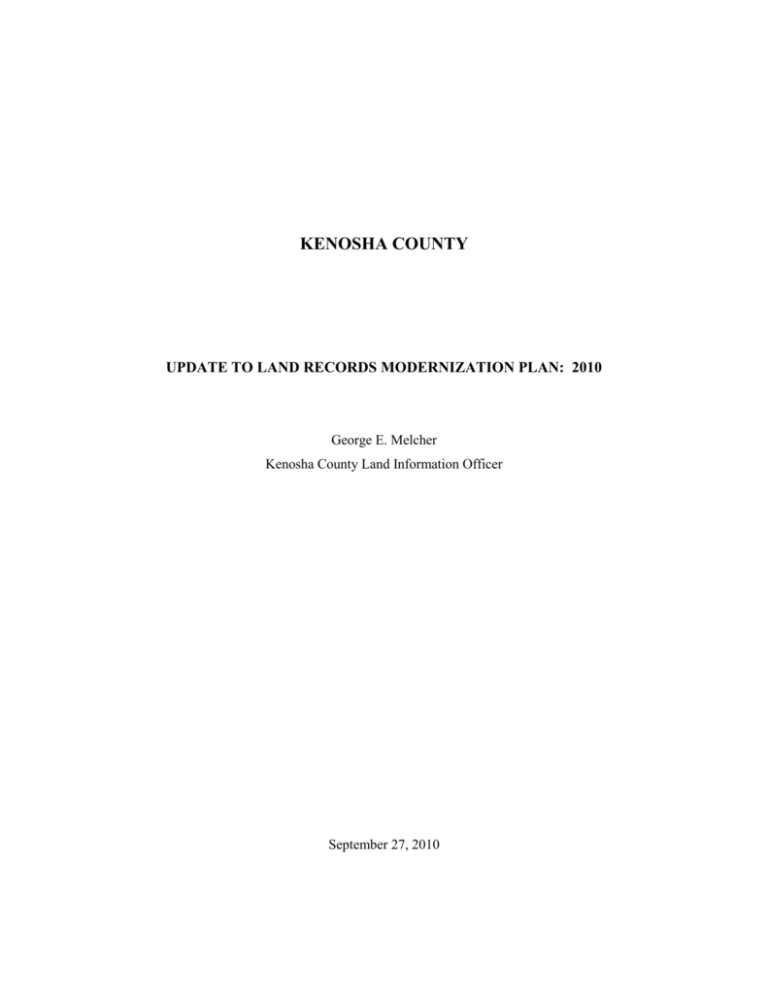PCE/rj - Department of Administration
advertisement

KENOSHA COUNTY UPDATE TO LAND RECORDS MODERNIZATION PLAN: 2010 George E. Melcher Kenosha County Land Information Officer September 27, 2010 I. EXECUTIVE SUMMARY A. Identification and Contact Information Mr. George E. Melcher Kenosha County Land Information Officer Kenosha County Center P.O. Box 520 Bristol, Wisconsin 53104-0520 Telephone: (262) 857-1895 B. Participants in the Planning Process On September 25, 1990, the Kenosha County Board of Supervisors adopted SEWRPC Community Assistance Planning Report No. 185, A Plan for the Creation of an Automated Mapping and Parcel-Based Land Information System for Kenosha County, August 1990 (hereinafter referred to as the “plan”). This document, prepared in 2010, is intended to update, expand, and extend that plan and subsequent updates. Policy direction in the development of this document was given by the Kenosha Area Land Management (KALM) Committee, an internal Kenosha County group charged with the responsibility of implementing the plan. The KALM Committee includes: the Kenosha County Land Information Officer and Director of Planning and Development; the Kenosha County Director of the Division of Planning Operations; the Kenosha County Director of the Division of Land Information; the Kenosha County Register of Deeds; the Kenosha County Treasurer; the Kenosha County Clerk; and the Kenosha County Information Technology Applications Services Manager. Support services in developing the original plan were provided by the staff of the Southeastern Wisconsin Regional Planning Commission. Under the requirements of the State of Wisconsin 2009 Act 14, Kenosha County established a Land Council on August 17th, 2010. The council consists of the following members: Louise I. Principe, Kenosha County Register of Deeds Teri Jacobson, Kenosha County Treasurer Al Brokmeier, Kenosha County Real Property Lister Martin Lacock, Other Public Designate – Information Technologies Representative John O’Day, Kenosha County Board Representative Dr. Kurt W. Bauer, Kenosha County Surveyor Joe Huck, Realtor George E. Melcher, Kenosha County Land Information Officer Edward VanTine, Public Safety/Emergency Communications Representative This Council is charged with reviewing the priorities, needs, policies, and expenditures of the land information office and will advise the County on matters affecting the land information office. As part of the responsibilities for which it was created, the Land Council will review and modify this document prior to filing with the State of Wisconsin Department of Administration. -2- C. Summary of Plan This document is intended to provide County and local officials, State agencies, private entities, and other interested parties with basic knowledge of Kenosha County’s continued efforts to modernize its land records system. Since adoption of the original plan in 1990, Kenosha County has diligently pursued the creation of a parcel-based, multi-purpose, multi-user land information system. The initial focus was on the establishment of a geodetic framework, the preparation of large-scale topographic maps, and the preparation of companion large scale cadastral maps. Originally created using pen and ink cartographic methods on stable mylar based materials, all maps have since been converted to digital form and have been integrated into a computerized database now serving Kenosha County. This updated document summarily describes how Kenosha County intends to continue to build on that database over the next several years and to expand our cooperation with local units of government in the County and with the Wisconsin Land Information Program in pursuing important land records modernization initiatives. D. Kenosha County Land Information Website The Kenosha County website: http://www.kenoshacounty.org E. Websites Serving Land Information For Municipalities Within Kenosha County The City of Kenosha: The Town of Brighton: The Town of Bristol: The Town of Paris: The Town of Randall: The Town of Salem: The Town of Somers: The Town of Wheatland: The Village of Bristol: The Village of Genoa City: The Village of Paddock Lake: The Village of Pleasant Prairie: The Village of Silver Lake: The Village of Twin Lakes: II. http://www.kenosha.org http://www.brightonwi.com/ http://www.town.bristol.wi.us http://www.town-of-paris.org http://www.townofrandall.com/ http://www.townofsalem.net/ http://www.somers.org/ http://www.townwheatland.com/ http://www.town.bristol.wi.us http://www.genoacity.info/ http://www.paddocklake.net/ http://www.pleasantprairieonline.com http://www.vi.silverlake.wi.gov http://www.villageoftwinlakes.net LAND INFORMATION PLAN A. Goals and Objectives The Kenosha Area Land Management (KALM) system implementation, discussed in greater detail in the following sections of this document, has resulted in improvement of both efficiency and effectiveness in the acquisition, conversion, storage, and retrieval of -3- information about the land which comprises Kenosha County. Overarching goals and objectives for the development and continued enhancement of the KALM system are as follows: The reduction of duplication of effort within Kenosha County government and between the County and other levels of government. The improved accessibility, usability, completeness, accuracy, and timeliness of land information for the use of Kenosha County departments, other local units of government, public utilities, and the public. The support of improved information analysis, decision support, and public administration. The preservation of the existing public investment in the development of the KALM system through the exercise of proper and complete system maintenance activities. The evaluation of future projects and the funding mechanisms needed for the enhancement of the land records modernization process. A number of Kenosha County governmental functions existing under the Wisconsin Statutes, such as the Register of Deeds, Treasurer, Clerk, County Surveyor and Real Property Lister, have statutory duties that result in the collection of primary data. The statutes provide for a geographic basis in referencing lands. The County exercises diligence to ensure that its responsibilities in these areas are discharged in a complete, effective, and cost-efficient manner to those individuals that utilize the land base system. In other areas-such as the County planning function-where the County is predominantly a secondary user of land information, the County attempts to secure the use of information already collected by other sources and resorts to primary data collection only when suitable information sufficient for the tasks at hand are unavailable from other sources. Kenosha County currently relies upon numerous state and local sources for various types of data and information necessary to conduct County business. This information includes, but is not limited to; environmentally themed spatial datasets created by the Southeastern Wisconsin Regional Planning Commission and the State of Wisconsin Department of Natural Resources; property assessment information maintained by local municipal assessors; and various records maintained by the State of Wisconsin Department of Revenue. Furthermore, the County would like to acquire more data such as: detailed building and new construction information from local units of government; tax collection data from local units of government; updated FEMA DFIRM floodplain mapping based upon detailed County mapping; and updated census datasets. The problems in acquiring such information often include data format compatibility issues, questionable data accuracy, and the availability of funding. Kenosha County plans to continue utilizing widely accepted data format standards and software systems. The County also provides export capabilities to alternate data formats. The County will continue to maintain spatial data in the Wisconsin State Plane Coordinate System North American Datum 1927 (and the National Geodetic Vertical Datum 1929), a system that can be easily transformed with popular GIS software packages and may explore -4- alternative spatial data sets in the future. In addition, Kenosha County is dedicated to the adherence of Wisconsin Land Information Program (WLIP) standards, further ensuring common spatial reference to County datasets. In carrying out its responsibilities relating to land information and associated systems, Kenosha County is guided by the criteria set forth below: - To the extent that the available technology and the available funding sources permit, Kenosha County will take steps to ensure that the information resident in its land records systems is readily transmissible for use by any State, County, or local government department or agency, or by any public utility. - To the extent that the available technology and the available funding sources permit, Kenosha County will take steps to ensure that the information resident in its land records systems is easily retrievable by any State, County, or local government department or agency, or by any public utility. - To the extent that the available technology and the available funding sources permit, Kenosha County will take steps to ensure that the information resident in its land records systems is geographically accurately referenced for use by any State, County, or local government department or agency, or by any public utility. Kenosha County’s computer operating systems environment and database designs are configured around open architecture conventions. This allows the County to have multiple hardware platforms which use an integrated database. This also simplifies the interchange of information between the County and other governmental and private entities. B. Progress Report 1. Historical Progress When the first Kenosha County Land Records Modernization Plan was completed in 1990, the County had already made significant progress toward the establishment of a countywide automated mapping base. All of the 1,203 U.S. Public Land Survey (USPLS) corners in the County had been relocated and permanently monumented. State Plane Coordinates and elevations had been determined for all 1,203 USPLS corners, and 1:2400 scale (one inch equals 200 feet) topographic base maps with a two foot contour interval had been completed in hardcopy format for all 278 square miles of the County’s jurisdictional area. The County began building a digital parcel map capability in the years between 1980 and 1985, and by 1990 had completed a digital mapping base for an area of about 112 square miles, representing about 40 percent of the area of the County, and including about 30 percent of all real property parcels located in the County. This digital mapping base utilized the previously completed system of USPLSS corner monumentation and control surveys to provide a mathematically rigorous geometric framework for the creation of the digital map files. -5- The digital map files were comprised of map elements created through the digital conversion of selected map features taken from the large scale topographic base maps; a real property boundary line, or parcel, map overlay delineating all ownership parcels; a parcel identification numbering system providing for the unique identification of each ownership parcel in the County; and a series of digital map overlays created for County planning and zoning administration activities. These additional digital map layers included flood hazard areas and shoreland zoning areas; existing land use, including wetlands; soil mapping units; and County and municipal zoning districts. Therefore, by the time the WLIP was initiated in 1990, a significant portion of the initial effort necessary to begin the development of a countywide automated mapping and land information system had already been accomplished in Kenosha County. The creation of the WLIP in 1990 provided a dedicated funding source for land records modernization activities through a document recording fee surcharge collected by the County Register of Deeds Office. In order to use the funds, the County was required to prepare--and have reviewed by the Wisconsin Land Information Board--a County plan for land records modernization activities and was further obligated to use the retained funds, plus any grants obtained under the Program, strictly for implementation of the adopted plan. Given the then perceived short term nature in 1990 of the WLIP funding stream--the legislation creating the program provided only for a five year window for collection of the document recording fee surcharge, a condition which has since been removed; the level of funds projected to be available to the County over the expected five year life of the program; and the status of the work already completed by the County in the creation of the automated mapping base; the Land Records Modernization Plan adopted by the Kenosha County Board of Supervisors on September 25, 1990, and reviewed and accepted by the Wisconsin Land Information Board on January 7, 1991, was focused on the completion of the automated mapping base for the remaining 60 percent of the County’s land area. Secondary objectives included the acquisition of a basic computer hardware and software capability for manipulating the digital map files; training County staff in the use of the system of digital map files and the attendant computer software; and establishing a limited maintenance and updating program intended to keep the completed digital map files current during the period through which the basic automated mapping system was being completed. By the end of 1997, these initial plan objectives had all been attained. During this same time period, Kenosha County also undertook modernization activities in other land records areas using local funding sources. Among these initiatives were the implementation by the Kenosha County Register of Deeds office of optical imaging capabilities which has been completed and is used to streamline the recording of deeds and associated documents. The County also undertook the creation of a single database for the storing of information associated with land parcels and undertook several projects that resulted in the creation of automated information flows between various Kenosha County Departments, including the Register of Deeds Office, the Land Information Office, the Clerk’s Office, the Planning and Development Office, and the Treasurer's Office. This organization of processes allows the County Information Systems Department to present a uniform set of information to other County departments, County municipalities, and outside agencies as one seamless flow of information. This body of processes and information flows has been given the acronym KALM (Kenosha Area Land Management). -6- The advantages of this data organizational structure and process include: Elimination of redundancy Common editing and validation checking for data entry. Tracking of changes to the data base. Easily accessible digital images of recorded documents. Linking of information with the digital base map. Consistent presentation of information to all users. Accurate history of parcel splits and combinations. Consistent representation of parcel owner names and addresses. • Publication of land records to the public via the internet 2. Ongoing Activities Due to the efforts of the Kenosha County Executive, Kenosha County Board, KALM committee, and periodically through the assistance provided by the WLIP to date, Kenosha County has either started or completed numerous initiatives identified on previous updates to this plan: • • • • • • • • • The creation of an electronic file of land survey data. This includes the scanning of plats of survey and USPLSS monument “dossier” sheets and the connection of surveys and tie sheets to the geographic information system. Public access terminals at the western Kenosha County Center. The development of data sharing agreements with utility companies and State agencies. Regular maintenance of the GIS building and structure layer The development of a tax roll system available for public viewing online. Conversion from the Genasys GIS software platform to the ESRI GIS platform. The creation of a GIS Systems Coordinator position. The creation of a historical annexation spatial dataset and attribute table. The creation of a subdivision spatial dataset and attribute table. The enhancement of Internet access to Kenosha County land records, maps and imaged documents. The enhancement of the 911 parcel address system and support of wireless 911 efforts. The creation of an internet based interactive mapping application The support of the SmartGrowth comprehensive planning process. The expansion of the tax roll data available for public viewing on-line to include current delinquent tax amounts. -7- Electronic transfer of building information Data collection and integration of GPS data. The migration of spatial datasets to ESRI’s ArcSDE format. Given the active level of implementation of Land Records Modernization Activities by Kenosha County since 1990, this update of the Kenosha County Land Records Modernization Plan will focus on activities intended to preserve the value of the public investment already incurred, this includes: maintenance of the U. S. Public Land Survey system of monuments and attendant control surveys, the automated mapping base, various attributed information linked to that mapping base, optical imaging and automated tracking of records, and integrated receipting and related technical support. Moreover, the updated plan will follow the guidance established by the Wisconsin Land Information Program to improve access to public and private parties to all available data. Finally, the plan will identify additional land records modernization projects intended to provide more efficient and effective services to Kenosha County residents. C. New Initiatives Proposed Projects Much of the effort to be undertaken over the next several years in Kenosha County involves the maintenance of the land records systems that have already been automated. If funding and staff time allow, Kenosha County will further develop and enhance the land records system through a number of projects. These include, but are not necessarily limited to, the following: • • The continued enhancement of Internet based access to Kenosha County land records, maps and imaged documents. The continued enhancement and support of the 911 parcel address system and wireless 911 implementation. The development of address tracking methodology The timely updates of tax payment information The creation of digital & hard copy property sale maps and possible inclusion on web site. Creation and publication of property sales information. Creating electronic retrieval of Historical Register of Deed Index and Records. Incorporation of Circuit Court Information into an Intranet database including divorce, and court case information. The creation of a map archival system The development of Internet access to information on tax deeded properties. Development of internet based access to data regarding foreclosed properties and properties to be foreclosed. The development of a system to allow local governments in the County to query Kenosha County databases and create their own maps. The development of an Intranet capability to allow Kenosha County departments to create their own maps. -8- Attempt to incorporate parcel addressing for the Villages of Kenosha County other than Pleasant Prairie into the uniform numbering and addressing system maintained by the Land Information Division. Electronic transfer of survey information Development of updated topographic mapping data including a countywide digital elevation model using LIDAR technology. Acquisition of seamless datasets for bordering counties within the State of Illinois to study cross-jurisdictional issues. Integration of Emergency Management Data including Homeland Security efforts The development of crime incident mapping. Continued staff development through various land records software training programs. The expansion of land information record access to be utilized in Health and Human services projects. The development of processes to provide electronic property assessment data to the State of Wisconsin. Publish imaged tax bills on the internet Create GIS layer of “ready-to-build” properties Redact personal information from previously recorded documents Transfer data automatically from State transfer form to County database Provide alternate database to hold property split and combination information Provide mechanism to allow for maintaining multiple addresses on each property in Kenosha County tax parcel system as needed Work with U.S. Postal Service data to reconcile and enhance County address data Enhance shoreland protection zone mapping/records Work with the Department of Revenue to create electronic assessment card technology Image various land records related paper documents Publish dates of tax payment payments on internet Assistance Requested Kenosha County currently subscribes to the Technical Assistance List Server and will continue to seek assistance and guidance from the WLIP community. Kenosha County also remains committed to securing the long term viability of any previous investments created in part by Land Information Program funding. All county land information projects are subjected to fiscal maintenance considerations at the time of project planning. In addition, Kenosha County intends to utilize competitive procurement processes consistent with state and local procurement rules. Problems Encountered The major constraint in the further development and enhancement of the Kenosha County land records system is funding and associated staffing. The system is funded through the use of retained land records fees, grants from the WLIP, and county tax levy monies. The grant funding assistance provided by the WLIP is slowly dissipating. With the lack of availability of program funds, Kenosha County is becoming more reliant upon the county tax levy to fund land records modernization activities. Such tax levy monies are highly variable and subject to the policy determinations of the state and local budget process. The -9- general enhancement of the grant program is necessary to protect the integrity of Kenosha County’s land records modernization accomplishments. D. Custodial Responsibilities Kenosha County officials and the newly established Land Council have a number of custodial responsibilities attendant to land records data in accordance to the provisions of the Wisconsin Statutes. These include County Surveyor responsibilities (monuments and reference benchmarks related to the U. S. Public Land Survey system, plats of survey); County Treasurer responsibilities (tax rolls, tax receipts, and tax certificate books); County Register of Deeds’ responsibilities (all recordable property-related instruments); and County Tax Lister (assessment roll, tax parcel numbers, and related property tax data). In addition, Kenosha County will assume the custodial responsibilities for the following land records information: The horizontal and vertical control survey data associated with the U. S. Public Land Survey system monuments. Large-scale planimetric and topographic base maps. Parcel maps. Orthophotography (jointly with SEWRPC). Street naming and addressing. As fiscal resources permit, Kenosha County will maintain the foregoing information and derived products that flow from that information. Kenosha County will work with other parties to define custodial responsibilities for the other foundational elements in the land information system. E. Framework Data, System Implementation and Statewide Standards 1. Geographic Positioning Reference Frameworks Geodetic Control and Control Networks Kenosha County has densified the national geodetic control network for use in the County. This work was completed during 1988 and predates the formation of the Wisconsin Land Information Program. The horizontal control survey work undertaken in Kenosha County included the recovery or relocation and monumentation of 1,203 U.S. Public Land Survey corners, including section and one-quarter-section corners, centers of sections, and closing corners. Having recovered, or relocated, and monumented these corners, high-order control survey traverses were run which utilized and incorporated all of the monumented corners as stations to determine the coordinates of the corners and the lengths and bearings of all quarter-section lines. Coordinates of the corners on the Wisconsin Plane Coordinate System, South Zone, North American Datum of 1927, were computed, and sufficient survey connections were made to basic National Geodetic Survey (NGS) control stations of the NGS control net to permit the proper checks and adjustments to be -10- made both in the traverse lengths and bearings and in the coordinate values of the monumented U.S. Public Land Survey corners. The accuracy of the horizontal control surveys conformed to the specifications for NGS Third-Order Class I accuracy for traverse. The vertical control survey work was based upon the National Geodetic Vertical Datum, 1929 Adjustment, as established by the NGS. Closed level circuits were run as necessary to establish permanent bench marks throughout the County. All level circuits met or exceeded specification for NGS Second-Order, Class II accuracy and were adjusted for closure by NGS methods. Elevations were determined for the monuments marking the section and quarter-section corners through-out the County, and these monuments serve as permanent bench marks, each monument being supplemented by at least one reference bench mark. Public Land Survey System remonumentation and records automation In concert with the establishment of the County geodetic control network, 1,203 permanent monuments have been placed to mark the U.S. Public Land Survey System. These monuments mark all of the U. S. Public Land Survey System corners in Kenosha County. This work was completed during 1988 and predates the formation of the Wisconsin Land Information Program. The specifications governing the creation of the necessary survey control network require the relocation of all U.S. Public Land Survey corners in the area concerned, and the marking of the relocated corners by reinforced concrete monuments, with engraved bronze caps imbedded in the tops. The bronze caps are inscribed with the corner notation--quarter section, town, and range. The monuments placed are referenced by ties to at least four witness marks. The specifications require that the survey engineer and land surveyor provide a dossier on each control station established in order to permit its ready recovery and use. The dossier sheets provide for each station a sketch showing the monument erected in relation to the salient features of the immediate vicinity, all witness monuments together with ties, the state plane coordinates of the corner, its U.S. Public Land Survey description, the elevation of the monument, and the location and elevation of appurtenant reference benchmarks referred to the National Geodetic Vertical Datum of 1929. These dossier sheets are recorded with the County Surveyor as well as with the Southeastern Wisconsin Regional Planning Commission, and are thereby readily available to all land surveyors and public works engineers operating in the area. The specifications utilized in the conduct of this work require the control survey data to be summarized by means of a control survey summary diagram showing the exact grid and ground lengths and grid bearings of the exterior boundaries of each U.S. Public Land Survey quarter section; the area of each quarter section; all monuments erected; the number of degrees, minutes, and seconds in the interior angles of each quarter section; the state plane coordinates of all quartersection corners together with their Public Land Survey System identification; the bench mark elevations of all monuments set; and the basic National Geodetic Survey control stations utilized to tie the Public Land Survey corners to the horizontal geodetic control datum, together with the coordinates of these stations. -11- The angle between geodetic and grid bearing is noted on the diagrams, as is the combination sea-level and scale-reduction factor. 2. Orthoimagery and Georeferenced Image Base Data Photogrammetrically Prepared Base Maps Kenosha County has completed the acquisition of photogrammetrically prepared base maps for the entirety of the County. These base maps are in the form of 1:2400 scale (one inch equals 200 feet) two foot contour interval topographic maps. These maps were completed in analog format in the years up to and including 1988 and predate the formation of the Wisconsin Land Information Program. On an annual basis, the County acquires about seven square miles of replacement topographic mapping in areas of physical change. Beginning in 1994, this replacement mapping has been acquired in digital format. The specifications governing the preparation of the topographic mapping provide for the completion of finished topographic maps accurately recording the basic geography of the area mapped. In addition to showing the usual contour information, spot elevations, planimetric and hydrographic detail, and coordinate grid ticks, the maps show, in their correct position and orientation, all U.S. Public Land Survey quarter-section lines and corners established in the control surveys. The specifications required that all state plane coordinate grid lines and tick marks and all horizontal survey control stations be plotted to within 1/100 inch of the true position as expressed by the coordinates for the control survey stations. The specifications further required that the planimetric features and contours shown on the maps conform to National Map Accuracy Standards. Thus, 90 percent of all well-defined planimetric features must be plotted to within 1/30 inch of their true positions, and no such features may be off by more than 1/20 inch. Ninety percent of the elevations indicated by the solid-line contours must be within one-half contour interval of the true elevations, and no such elevation may be off by more than one contour interval. A combination sea level and scale-reduction factor, and the angle between geodetic and grid bearing, were noted on each map sheet, as was the equation between any local datum and mean sea level. Digital Orthophotography (DOP) Kenosha County has acquired copies of the digital orthophoto coverage completed by the Southeastern Wisconsin Regional Planning Commission in the spring of 2005. These color orthophoto files were compiled at a one-inch-equals 200 feet (1’=200’) scale with a pixel resolution of 12” and the project was designed to meet National Map Accuracy Standards at that scale. Additionally, Kenosha County, in conjunction with the Southeastern Wisconsin Regional Planning Commission, has initiated the 2010 orthophotography program. The aerial photo acquisition portion of the project was flown in April of 2010. The remaining data processing portions of the project are tentatively scheduled to be completed by early 2011. The project will provide color -12- orthophoto files compiled at one-inch-equals 50 feet scale with a pixel resolution of 3” and is designed to meet National Map Accuracy Standards at that scale. Kenosha County will continue to work with the Regional Planning Commission in obtaining updated orthophotography at five-year intervals. Wisconsin Land Information Program funds may be used to help fund such future efforts. 3. Digital Raster Graphic Kenosha County has not acquired, nor does it intend to acquire, digital raster graphics files prepared from United States Geological Survey map sources. Larger-scale, higher resolution, digital raster images more suitable for county and local government needs and uses are available through the use of the digital orthophoto images described above. Satellite Imagery Due to the relatively small scales and coarse image resolution that characterize the currently available satellite imagery, Kenosha County does not currently utilize this imagery in any manner. Kenosha County staff will continue to monitor the changing technology in this arena. ● Oblique Aerial Imagery Kenosha County has not acquired oblique aerial imagery, but does understand the utility it provides specifically in the law enforcement and emergency management aspects of local government. Kenosha County will continue to evaluate the purchase of an oblique aerial product. ● Historical Aerial Imagery Kenosha County has acquired digital orthophotography for the 1995, 2000 and 2005 project years and intends to acquire all future orthophotography projects in digital format. All digitally formatted projects are freely available on the Kenosha County Interactive Mapping website found at http://www.co.kenosha.wi.us/plandev/mapping/interactive_map.html Pending the appropriation of necessary funding, Kenosha County intends to convert the historical aerial photography project years of 1990, 1985, 1980, 1975, 1970, 1967 and 1963 into digital format for inclusion on the interactive mapping website. Elevation Data Products and Topographic Base Data ● Digital Elevation Models Beginning in 1998, Kenosha County specifications for digital topographic mapping were revised so that digital terrain models would be developed in conjunction with areas for which revised digital topographic mapping is acquired as part of the County’s annual topographic map maintenance program. The County has taken delivery of approximately 75 one square mile DEM’s since that time. ● Triangulated Irregular Networks Kenosha County, since 1998, has collected digital terrain models capable of supporting the creation of such networks. -13- 4. ● Contours Kenosha County topographic base maps contain two-foot interval contours prepared in analog format for the entirety of the County. These contour lines have been converted into digital format. The County has initiated a revised topographic mapping program beginning in 2010 to acquire one-foot contours countywide with final deliverables expected sometime in 2012. ● LIDAR Data The County has initiated a revised topographic mapping program starting in 2010 to leverage LIDAR mapping technologies. This new program will provide a LIDAR based bare-earth model, 1-foot contours and spot elevations countywide. Parcel Mapping ● Property Map Preparation Kenosha County has completed the compilation of digital real property boundary line maps for the entirety of the County. These maps have been prepared as companion overlays to the topographic base maps described in the preceding section of this document. Accordingly, these maps have a compilation scale of 1:2400 (one inch equals 200 feet) and are referenced to both the U.S. Public Land Survey System and the Wisconsin State Plane coordinate system. This mapping activity was initiated in 1984 prior to the formation of the Wisconsin Land Information Program and was completed during 1995. The earlier work consisted of board digitizing of inked manuscript maps, but, by the conclusion of the conversion process, coordinate geometry computer software was being utilized to compile parcel layouts. Utilizing recorded subdivision plats, certified survey maps, and legal descriptions, all real property boundary lines, including street right-of-way lines and major utility easement lines, were constructed working within the framework of control provided by the ground lengths and grid bearings of the U.S. Public Land Survey quarter-section lines. The property boundary lines were constructed in a manner that parallels the location of these lines on the surface of the earth following land surveying practice in the State of Wisconsin. The specifications utilized required that all real property boundary lines be plotted within 1/30 inch of their true position based on analysis of all authoritative information available. Dimensions are shown for all platted areas as provided on the recorded subdivision plats. Wisconsin law has long required that such plats be prepared to an accuracy of one part in 3,000, as compared to the accuracy of one part in 10,000 required by the specifications for the basic survey control network. Any overlaps or gaps between adjoining property boundary lines, as indicated by the construction and plotting of those lines, were noted on the cadastral maps. Finally, a cadastral parcel identification number was added. The property boundary line maps thus show the ground length and grid bearing of all quarter-section lines; the state plane coordinates of all quarter-section corners; the monuments marking these corners; the recorded dimensions of all street lines, alley lines, and boundaries of public property; recorded street widths; platted lot dimensions; and a parcel identification number. In unplatted areas, -14- real property boundaries are often shown by scale alone. Railway tracks, electric power transmission lines, principal structures, fences, wetlands, lakes, streams, and drainage ditches can also be shown. As previously noted, these boundary line maps can be readily and accurately updated and extended as new land subdivision plats and certified map surveys, utilizing the survey control, are made and recorded. 5. Parcel ID Kenosha County's digital parcel maps contain parcel identification numbers for linkage to associated nongraphic attribute data files. The parcel number identification scheme is compliant with the WLIB standard. Parcel Administration and Assessment Information Parcel Overview The Kenosha County land information system contains and integrates property and ownership records with both recorded and mapped boundary information and includes a parcel identifier referenced to the U. S. Public Land Survey system. • Parcel ID The Kenosha County Land Information System utilizes the parcel identification number to establish correspondence between the digital parcel maps and attribute information, both digital and analog, associated with the parcel. Tax Data The Kenosha County Land Information System permits the automated linkage of parcel information with tax status information concerning the parcel. Real Estate Transactions Kenosha County uses conveyances of real property recorded at the Register of Deeds Office to update digital property division files. Real estate transactions have been imaged by the Register of Deeds Office since 1994, and the County is now beginning to scan documents recorded prior to that year. The imaged documents have been integrated for inter-departmental access. Imaged documents are available to the public and private sectors on CD-ROM. By Kenosha County Ordinance, all documents must list a parcel number. Transfer returns are required to contain parcel identification numbers which are verified by the Land Information Office. Liens A recorded lien associated with real property is required to contain a tax parcel identification number. There remains a need to ensure that circuit court orders that affect real property are also related to tax parcel identification numbers. Evidence of Title Parcel maps are updated only through recorded evidence of title with the Register of Deeds Office. The Register of Deeds has indexed information by grantor/grantee, metes and bounds, and document number. Legal descriptions -15- and parcel numbers are verified for accuracy. Indexing by parcel identification number is currently underway. 6. Address Kenosha County assigns addresses in all Towns. Address assignment is based on a grid system and is administered through guidelines stated in Chapter 6 of the Kenosha County Municipal Code. The City of Kenosha and Villages assign addresses independently. The grid system is utilized by the City of Kenosha and the largest village in Kenosha. Address information is transferred freely between the City of Kenosha, the villages and Kenosha County to maintain an accurate physical property data base. Physical address map layers are under development for 911 and other emergency dispatch purposes. Tax data The Kenosha County Land Information System permits the automated linkage of parcel information with tax status information concerning the parcel. Assessment class Local municipal assessors are given the option to go on line with the Kenosha County assessment program. Those assessors who are linked to the Kenosha County assessment program enter and maintain assessment class codes. Those assessors who do not opt to use the Kenosha County system provide the codes to the County for data entry. Zip codes (including +4) Zip codes are maintained in fields that can be linked to parcel maps. The zip plus 4 has been implemented. Tax exempt lands Tax exempt lands are identified through assessment class codes. Kenosha County has the ability to link parcel class codes with the automated parcel information data base through the parcel identification number. Adherence to Standards The Kenosha County parcel identification numbering scheme is compliant with the WLIB standard. Street/Road Centerlines, Address Ranges and Address Points ● Rights of Way As part of the aforementioned parcel mapping, Kenosha County maps rights of way for public streets and railroads utilizing recorded documents and registered surveys and includes easements for ingress and egress whenever possible. ● Street Centerlines Kenosha County has established a separate layer of road centerlines and has populated this dataset with numerous data attributes including address ranges, functional class, street naming conventions and municipality. This dataset was created to support wireless 911 and emergency planning. Attributes in the street -16- centerline file are integrated with the naming conventions found in the County/City Master Street Address Guide. 7. ● Site Addresses A layer of site addresses has been created for the purposes of the wireless 911 implementation. The source documents used for this layer included County tax records and some limited information obtained from the U.S. Postal Service. All address points are placed on the parcel at the access point (i.e. driveway) on the parcel. Kenosha County intends to further enhance this layer with more comprehensive data obtained from the U.S. Postal Service. ● Places/Landmarks Kenosha County has mapped a limited amount of place and landmark features. As necessary resources and funding become available, additional features will be added to this dataset. Hydrography, Hydrology and Wetlands Mapping ● Hydrography The countywide hydrography data found within the land records system were developed in conjunction with the photogrammetric base mapping. These maps were created at a 1:2400 scale and were collected at various times predating the formation of the Wisconsin Land Information Program. ● Watersheds Kenosha County, with the assistance of the Southeastern Wisconsin Regional Planning Commission, has collected watershed boundary information depicting primary watersheds and subwatersheds throughout the County. With the planned revised topographic mapping program using LIDAR technologies beginning in 2010, the County will enhance the current watershed boundaries and create further subdivisions of the subwatersheds as needed. ● 8. Wetlands Mapping Activities The wetland mapping files used by Kenosha County were compiled by the Southeastern Wisconsin Regional Planning Commission on behalf of the Wisconsin Department of Natural Resources as part of a cooperative agreement to update the Wisconsin Wetland Inventory in Southeastern Wisconsin. The digital map files were compiled with reference to one-inch-equals-200-feet-scale orthophotography acquired in the spring of 2005, and also with reference to land use, vegetation, topographic, and soils information. Some wetland areas were field checked in 2006 and 2007 to confirm wetland boundaries and characteristics. Soils Mapping, Land Cover and Other Natural Resource Data The Kenosha County digital map holdings include representations of Soil Conservation Service (now Natural Resources Conservation Service) delineated soil mapping units obtained from and originally converted to digital format by the Southeastern Wisconsin Regional Planning Commission. The soil mapping unit lines have been spatially adjusted to the U.S. Public Land Survey section level. The Kenosha County digital soil maps were created prior to the -17- development of the Natural Resources Conservation Service (NRCS) digital soil mapping specifications. Additionally, Kenosha County has taken delivery of the NRCS developed SURGO soils mapping and uses it in conjunction with the legacy soil data. 9. Land Use Mapping ● Existing Land Use The Kenosha County Land Information System contains a digital land use layer based on field conditions in the year 2000. The land use maps were originally compiled in digital format by the Southeastern Wisconsin Regional Planning Commission and obtained from the Commission by the County. The land use boundaries have been spatially adjusted to the parcel level. The land use classification system is not the same system used by the Wisconsin Department of Revenue but is the system promulgated by the U.S. Department of Transportation. ● Planned Land Use As part of the recent State of Wisconsin Comprehensive planning law initiative, Kenosha County has developed a comprehensive plan that will act as a long range guide for Kenosha County and its citizens to effectively address future development and natural resource protection in the County through the year 2035. As part of this process, numerous data layers, including the planned year 2035 land use, were developed for use in the County Land Information System. 10. Zoning Mapping Zoning Districts The Kenosha County digital mapping holdings include representation of zoning district boundaries. These boundaries were originally compiled on the County’s analog format 1:2400 scale topographic base maps and were later board digitized. Since 1995, all Kenosha County zoning district amendments have been mapped using coordinate geometry procedures. Shorelands The Kenosha County digital map holdings include representations of shoreland areas. The lines were originally compiled on the County’s analog format 1:2400 scale topographic base maps and were later board digitized. Floodplains and floodways The Kenosha County digital map holdings include representations of floodplain boundary lines. The location of the lines were determined by hydraulic modeling techniques, compiled on the County’s analog format 1:2400 scale topographic base maps and were later board digitized. ● Environmental Corridors The Kenosha County map holdings include representations of environmental corridors and planned environmental corridors as delineated by the Southeastern Wisconsin Regional Planning Commission. -18- 11. Election and Administrative Boundary System The following summarizes the development of a reconciled election and administrative boundary system in Kenosha County: Kenosha County has mapped its county boundaries and is working to incorporate datasets beyond the county limits for referencing purposes. Municipal boundaries have been mapped and are updated on a weekly basis to reflect annexations and other changes in boundary lines as dictated by local ordinances. Local sanitary sewerage service areas, public water utility districts and public lighting districts have been mapped and exist on layers within the land information system. These districts have been checked and confirmed by local municipalities and are updated periodically. Congressional, state, county, and municipal election districts have been identified and mapped. The County has created a public access data base that can readily identify all elected representatives for a given tax parcel, as well as the location of the polling place attendant to that parcel. The Kenosha County land information system includes all tax incremental financing districts outside of the City of Kenosha. The Kenosha County land information system includes the boundaries of all school districts. The Kenosha County land information system includes the boundaries of all special lake protection and rehabilitation districts. Kenosha County has imported census geography to the geographic information system and includes census blocks, block groups and tracts. Kenosha County has created a digital zip code layer. Kenosha County has mapped local emergency response districts. Kenosha County intends, at the earliest convenience possible and as funding and staffing resources allow, to incorporate 2010 Census datasets into the County land information system. All of the above-listed work is developed and maintained by Kenosha County personnel. Many of these activities were funded in part by Wisconsin Land Information Program monies. 12. Critical Infrastructure and Facilities Management The following summarizes the critical infrastructure and facilities management features within the Kenosha County land information system: ● ● ● ● As part of the wireless 911 implementation, Kenosha County has mapped emergency service districts, 911 call center locations, fire/police districts and fire/police station locations. Kenosha County has mapped the locations of hospitals and healthcare facilities The Kenosha County land information system includes government facilities locations Kenosha County has received limited amounts of utility mapping from government and private entity data sharing partners. Distribution of these -19- ● ● datasets by Kenosha County is strictly prohibited and must be requested from the authoritative data custodians. Kenosha County has mapped park and recreational trails including bicycle trails, hiking routes and snowmobile trails. Kenosha County has created an airport layer In the future, Kenosha County would like to map transit systems, bridges, culverts and traffic signage as time and resources permit. 13. Database Design and System Implementation In the development of land information projects, Kenosha County practices due diligence in the design evaluation stages to ensure project feasibility and timeliness. Additionally, metadata is developed whenever required. Security and privacy issues are also addressed at project inception. F. Public Access Use of technology to facilitate efficient access Kenosha County currently offers tax parcel attribute information on the Kenosha County website. This website, along with a joint project between the Southeastern Wisconsin Regional Planning Commission and its’ member counties, allow for limited access to parcel mapping. Kenosha County intends to expand access to the parcel mapping through the enhancement of current web based applications. Open access to data in existing format Kenosha County has developed policies related to data access. Mapping data is currently available to Kenosha County municipalities, state and regional agencies at no charge through the utilization of data sharing agreements. • Optional Data Dissemination In pursuit of enhanced services to the general public, Kenosha County does fulfill customized data requests in alternative formats on a cost recovery basis. System Security Kenosha County’s computer systems are secured through the use of profiles and passwords. A firewall is utilized between the system and any external access points. The security and integrity of the data residing on County systems are considered to be of the utmost importance and are always explicitly considered when designing access points to the systems. Privacy Policies Kenosha County complies with individual privacy rights as these rights are set forth in Wisconsin law. The County explicitly considers privacy issues prior to establishing policy concerning information available for release. • Use of $2 Retained Fee Kenosha County has used the $2 retained fee to publish land information and additional housing data per Sec. 59.72(5)(b)3. The use of those fees created the -20- property inquiry portion of the Kenosha County website found at: http://www.co.kenosha.wi.us/apps/propinq/propinq_policy.phtml Adherence to Standards Kenosha County’ systems are configured around open architecture conventions. This simplifies the provision of public access. Additionally, Kenosha County complies with State of Wisconsin Open Records Law and the Federal Freedom of Information Act for any assets found within the land information system. G. Integration and Cooperation Kenosha County seeks to achieve the highest level of integration and cooperation in the development and use of its county geographic information system. Kenosha County intends over the next several years to pursue enhanced cooperative work efforts with federal agencies, state agencies, local utilities, local municipalities, the Regional Planning Commission, and private businesses, all relative to land records integration. All of these cooperative and integrative work efforts are dependent upon continued strong funding for the land information system. The development of the KALM Committee and the newly formed Land Council within Kenosha County has ensured that the interests of all County Departments utilizing land records data are being represented. The efforts of these two groups have resulted in the development of numerous land records applications that benefits the needs of County staff as well as the general public. Local municipalities and other agencies benefit from the County’s program through the County’s use of data sharing agreements and publishing of land information to the internet: Formal data sharing agreements are in place between the Register of Deeds and local title companies. Under formal arrangements, local assessors directly enter data into the Kenosha County land information system. Kenosha County and its six sister counties in southeastern Wisconsin have a cooperative agreement, along with the Southeastern Wisconsin Regional Planning Commission, to share and publish certain land records data. Arrangements have been put in place to ensure that all local governments in Kenosha County have direct access to the Kenosha County public access land data base. Kenosha County has researched its options relative to copyrighting certain data in order to monitor the release and subsequent use of such data. Kenosha County will continue working with utilities and private sector organizations to develop future cooperative agreements. H. Communication, Education, Training and Facilitated Technical Assistance ● Technical Assistance Kenosha County has established a formal connection with the Wisconsin Land Information Program Technical Assistance List Server. Kenosha County currently has an internet address and will utilize the internet to connect to the -21- ● WLIP Technical Assistance List Server and to otherwise communicate with the Wisconsin Land Information Program. Use of Training and Education Funds Kenosha County will continue to use Wisconsin land Information Program Training and Education grant awards to enroll staff in lands records conferences and/or training. I. Administrative Standards Not associated With Foundational Elements The Kenosha County Land Records Modernization Plan represents an agreement between the County and the Wisconsin Department of Administration (DOA). This agreement is intended to effectuate the objectives of the Program as embodied in the enabling legislation. In order for a Plan to be acceptable to the DOA, the DOA and the County agree and consent as follows below: 1. Kenosha County agrees to observe and follow the statutes relating to the Wisconsin Land Information Program and other relevant statutes. 2. Kenosha County agrees to permit the Wisconsin Department of Administration access to books, records and projects for inspection and audit. 3. Kenosha County agrees to complete the GIS Inventory Survey. 4. Kenosha County agrees to update the plan every 5 years and in the interim if the plan should change. 5. Development and implementation of an acceptable plan confers certain benefits on local government within a county, including continued eligibility for Program funding. A peer review process will be used to assess plan acceptability by the land information community. ***** -22-







